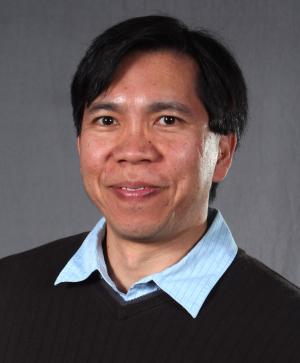Searching for Trigger
Math Cuajungco and Students Hunt for What Causes Mucolipidosis
A Cal State Fullerton biologist and his undergraduate co-researchers may have identified a cause of Mucolipidosis type 4 — a rare genetic disorder that results in lifelong psychomotor, vision and digestive problems.
The team, headed by Math Cuajungco, assistant professor of biological science, is delving into genetic mutations similar to those studied by his former mentor, Susan Slaugenhaupt of Harvard Medical School.
For most, zinc in their cells helps their health, but for those with the disorder, zinc and waste products build up and cells malfunction.
Cuajungco and senior biological science majors Jeffrey Evans and Jonathan Eichelsdoerfer have identified a genetic causes the zinc buildup. The team’s results, “Zinc Dyshomeostasis Is Linked With the Loss of Mucolipidosis IV-Associated TRPML1 Ion Channel,“ were posted online Sept. 23 on the Journal of Biological Chemistry website. The trio and Slaugenhaupt, who also contributed, are co-authors.
The researchers may have opened a new field of investigation, in the view of Paul Tanenholz, president of the Mucolipidosis IV Foundation. “It’s very exciting to hear about a possible building block to better diagnoses, or even a cure.”
The first task, said Cuajungco, was to develop human cells cultured in a dish.
“We had to coordinate the machines and chemical interactions so we could do this without killing the cells. It took a few attempts,” Evans said.
Eichelsdoerfer helped develop batches of usable kidney and mucolipidosis 4 patient’s skin cells. “I spent a lot of time using the spectrofluorometer, which sees a dye that glows when it attaches to zinc. That shows if a cell has zinc.”
The images garnered were the key to proving their hypothesis.
In the course of producing the results, Cuajungco also produced two new scientists and more material for his classes.
“I knew only a little bit about science when I started,” said Eichelsdoerfer, a Huntington Beach resident. “He has a three-step program: you saw it the first time, you did it the second time and you taught it the third time. It was a steep learning curve, but we learned fast and taught each other. We couldn’t just go through the motions.”
“I was naïve when I started,” said Evans of Orange. “I majored in business, but felt no passion. Then I took a biology class and was hooked, changed major and asked to be in his research. I wasn’t confident, though. I felt people successful in science had something I didn’t. But, I tend to go all out. Dr. Cuajungco saw that and worked me hard. I liked that.”
Both of them said Cuajungco did something else: “He also let us figure things out ourselves. We had to think and find solutions,” said Eichelsdoerfer. “He provided important problem-solving experience.”
“My criteria are not set in stone,” said Cuajungco of Pasadena. “Basically, I consider students who have a passion to learn and will take on challenges. I want students who show initiative, have common sense and can handle the rigors of research. I guess my degree in psychology helps me pinpoint the right ones.
“This research enriched my classes, too,” he said. “I introduce topics related to my research so students can see what they’re being taught can lead to research, and research is the pathway to many ‘miracles’ of modern medicine. Jon said that’s why he joined my team.”
Generating interest in research is part of the ongoing universitywide effort to expand science, technology, engineering and mathematics education.
Both Eichelsdoerfer and Evans say they’re considering becoming research physicians now.
Evans explained, “I like the idea of pushing research boundaries. In the 1990s, gene therapy was big, then faded. I believe if techniques are improved, it could save lives. My priority is to make a difference, so I’m looking for an envelope to push.”
Dec. 21, 2010
 Math Cuajungco
Math Cuajungco